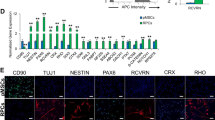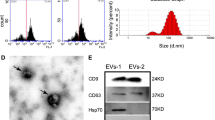Abstract
Mesenchymal stromal cells (MSC) stop or slow retinal pigment epithelium (RPE) and neuroretina (NR) degeneration by paracrine activity in oxidative stress-induced retinal degenerative diseases. However, it is mandatory to develop adequate in vitro models that allow testing new treatment strategies against oxidative stress before performing in vivo studies. The viable double- and triple-layered setups are composed of separate layers of NR, MSC, and RPE (NR–MSC–RPE, NR–RPE, MSC-RPE) partially mimic in vivo retinal conditions. In this study, the paracrine neuroprotective effect of each setup’s microenvironment on hydrogen peroxide (H2O2)-stressed was compared with unstressed RPE cells. RPE cell proliferation viability was assessed on day 1, 3, and 6 using Alamar Blue® (10%), MTT (10%) and a cell viability/cytotoxicity assay kit followed by data analysis. The results showed that RPE cells, highly viable (> 90%) in mixed medium of DMEM and neurobasal A (1:1), lost 50% viability on exposure to 400 µM of H2O2 (P < 0.05). The unexposed groups differed significantly from exposed groups for RPE cell growth (RPE and \({_{\text{H}_2\text{O}_2}}\)RPE (P < 0.0001), NR–MSC–RPE, and NR–MSC–\({_{\text{H}_2\text{O}_2}}\)RPE (P < 0.05), NR–RPE and NR–\({_{\text{H}_2\text{O}_2}}\)RPE (P < 0.01), and MSC–RPE and MSC–\({_{\text{H}_2\text{O}_2}}\)RPE (P < 0.01). NR–\({_{\text{H}_2\text{O}_2}}\)RPE and NR–RPE supported RPE cell proliferation viability better than other setups (P < 0.01) and RPE cells proliferated 0.49-fold more in NR-MSC-\({_{\text{H}_2\text{O}_2}}\)RPE than NR–MSC–RPE. Thus, NR and MSC presence improved significantly each setup’s microenvironment for cell rescue, nevertheless, each setup also showed limitations for its use as an in vitro study tool. Health of microenvironment of such setups depends on many factors including cell-secreted trophic factors.




Similar content being viewed by others
References
Beatty S, Koh H, Phil M, Henson D, Boulton M. The role of oxidative stress in the pathogenesis of age-related macular degeneration. Surv Ophthalmol. 2000;45:115–34.
Cai J, Nelson KC, Wu M, Sternberg P, Jones DP. Oxidative damage and protection of the RPE. Prog Retin Eye Res. 2000;19:205–21.
Winkler BS, Boulton ME, Gottsch JD, Sternberg P. Oxidative damage and age-related macular degeneration. Mol Vis. 1999;5:32.
Kay P, Yang YC, Paraoan L. Directional protein secretion by the retinal pigment epithelium: roles in retinal health and the development of age-related macular degeneration. J Cell Mol Med. 2013;17:833–43.
Kolomeyer AM, Zarbin MA. Trophic factors in the pathogenesis and therapy for retinal degenerative diseases. Surv Ophthalmol. 2014;59:134–65.
Labrador-Velandia S, Alonso-Alonso ML, Di Lauro S, García-Gutierrez MT, Srivastava GK, Pastor JC, Fernandez-Bueno I. Mesenchymal stem cells provide paracrine neuroprotective resources that delay degeneration of co-cultured organotypic neuroretinal cultures. Exp Eye Res. 2019;185: 107671.
Di Lauro S, Garcia-Gutierrez MT, Fernandez-Bueno I. Quantification of pigment epithelium-derived factor (PEDF) in an ex vivo coculture of retinal pigment epithelium cells and neuroretina. Allbiosolution. 2019;2:81–3.
Bortolotti F, Ukovich L, Razban V, Martinelli V, Ruozi G, Pelos B, Dore F, Giacca M, Zacchigna S. In vivo therapeutic potential of mesenchymal stromal cells depends on the source and the isolation procedure. Stem Cell Rep. 2015;4:332–9.
Lim MH, Ong WK, Sugii S. The current landscape of adipose-derived stem cells in clinical applications. Expert Rev Mol Med. 2014;16:e8.
Pikuła M, Marek-Trzonkowska N, Wardowska A, Renkielska A, Trzonkowski P. Adipose tissue-derived stem cells in clinical applications. Expert Opin Biol Ther. 2013;13:1357–70.
Kfoury Y, Scadden DT. Mesenchymal cell contributions to the stem cell niche. Cell Stem Cell. 2015;2015(16):239–53.
Nombela-Arrieta C, Ritz J, Silberstein LE. The elusive nature and function of mesenchymal stem cells. Nat Rev Mol Cell Biol. 2011;12:126–31.
Tsuji W, Rubin JP, Marra KG. Adipose-derived stem cells: implications in tissue regeneration. World J Stem Cells. 2014;6:312–3214.
Moviglia GA, Blasetti N, Zarate JO, Pelayes DE. In vitro differentiation of adult adipose mesenchymal stem cells into retinal progenitor cells. Ophthalmic Res. 2012;48(Suppl 1):1–5.
Rodriguez-Crespo D, Di Lauro S, Singh AK, Garcia-Gutierrez MT, Garrosa M, Pastor JC, Fernandez-Bueno I, Srivastava GK. Triple-layered mixed co-culture model of RPE cells with neuroretina for evaluating the neuroprotective effects of adipose-MSCs. Cell Tissue Res. 2014;358:705–16.
Singh AK, Srivastava GK, García-Gutiérrez MT, Pastor JC. Adipose derived mesenchymal stem cells partially rescue mitomycin C treated ARPE19 cells from death in co-culture condition. Histol Histopathol. 2013;28:1577–83.
Vossmerbaeumer U, Ohnesorge S, Kuehl S, Haapalahti M, Kluter H, Jonas JB, Thierse H-J, Bieback K. Retinal pigment epithelial phenotype induced in human adipose tissue-derived mesenchymal stromal cells. Cytotherapy. 2009;11:177–88.
Fernandez-Bueno I, Pastor JC, Gayoso MJ, Alcalde I, Garcia MT. Müller and macrophage-like cell interactions in an organotypic culture of porcine neuroretina. Mol Vis. 2006;14:2148–56.
Fernandez-Bueno I, Fernández-Sánchez L, Gayoso MJ, García-Gutierrez MT, Pastor JC, Cuenca N. Time course modifications in organotypic culture of human neuroretina. Exp Eye Res. 2012;104:26–38.
Di Lauro S, Rodriguez-Crespo D, Gayoso MJ, Garcia-Gutierrez MT, Pastor JC, Srivastava GK, Fernandez-Bueno I. A novel coculture model of porcine central neuroretina explants and retinal pigment epithelium cells. Mol Vis. 2016;22:243–53.
Nieto-Miguel T, Galindo S, Reinoso R, Corell A, Martino M, Pérez-Simón JA, Calonge M. In vitro simulation of corneal epithelium microenvironment induces a corneal epithelial-like cell phenotype from human adipose tissue mesenchymal stem cells. Curr Eye Res. 2013;38:933–44.
Galindo S, Herreras JM, López-Paniagua M, Rey E, Mata A, Plata-Cordero M, Calonge M, Teresa Nieto-Miguel T. Therapeutic effect of human adipose tissue-derived mesenchymal stem cells in experimental corneal failure due to limbal stem cell niche damage. Stem Cells. 2017;35:2160–74.
Srivastava GK, Martín L, Singh AK, Fernandez-Bueno I, Gayoso MJ, Garcia- Gutierrez MT, Girotti A, Alonso M, Rodríguez-Cabello JC, Pastor JC. Elastin-like recombinamers as substrates for retinal pigment epithelial cell growth. J Biomed Mater Res A. 2011;97:243–50.
Srivastava GK, Reinoso R, Singh AK, Fernandez-Bueno I, Martino M, Garcia- Gutierrez MT, Pastor JC, Corell A. Flow cytometry assessment of the purity of human retinal pigment epithelial primary cell cultures. J Immunol Methods. 2013;389:61–8.
O’Brien J, Wilson I, Orton T, Pognan F. Investigation of the Alamar Blue (resazurin) fluorescent dye for the assessment of mammalian cell cytotoxicity. Eur J Biochem. 2000;267:5421–6.
Al-Zamil WM, Yassin SA. Recent developments in age-related macular degeneration: a review. Clin Interv Aging. 2017;12:1313–30.
Petrus-Reurer S, Bartuma H, Aronsson M, Westman S, Lanner F, Kvanta A. Subretinal transplantation of human embryonic stem cell derived-retinal pigment epithelial cells into a large-eyed model of geographic atrophy. J Vis Exp. 2018. https://doi.org/10.3791/56702.
Flood M, Gouras P, Kjeldbye H. Growth characteristics and ultrastructure of human retinal pigment epithelium in vitro. Invest Ophthalmol Vis Sci. 1980;19:1309–20.
Singh AK, Srivastava GK, Martín L, Alonso M, Pastor JC. Bioactive substrates for human retinal pigment epithelial cell growth from elastin-like recombinamers. J Biomed Mater Res A. 2014;102:639–46.
Rohowetz LJ, Kraus JG, Koulen P. Reactive oxygen species-mediated damage of retinal neurons: drug development targets for therapies of chronic neurodegeneration of the retina. Int J Mol Sci. 2018;19:3362.
Kaczara P, Sarna T, Burke JM. Dynamics of H2O2 availability to ARPE-19 cultures in models of oxidative stress. Free Radic Biol Med. 2010;48:1064–70.
Salazar JJ, Van Houten B. Preferential mitochondrial DNA injury caused by glucose oxidase as a steady generator of hydrogen peroxide in human fibroblasts. Mutat Res. 1997;385:139–49.
Wankun X, Wenzhen Y, Min Z, Weiyan Z, Huan C, Wei D, Lvzhen H, Xu Y, **aoxin L. Protective effect of paeoniflorin against oxidative stress in human retinal pigment epithelium in vitro. Mol Vis. 2011;17:3512–22.
Srivastava GK, Dueñas-Laita A, Pastor JC. Dimethyl sulfoxide toxic and stimulation effects in retinal pigment epithelial cells. Allbiosolution. 2020;02:71–5.
Acknowledgements
This research work was performed under the approved research projects (Grant numbers PS09/00938, JCYL BIO/39/VA26/10 and VA386A12-2), and financed by the Centro en Red de Medicina Regenerativa y Terapia Celular de Junta de Castilla y León, 47011 Valladolid, Spain. David Rodriguez-Crespo has defended his Master's thesis on obtaining appropriate institutional approvals, which is available in the University library. The authors would like to say thanks to Miss M. Teresa García-Gutierrez for providing support in the laboratory for executing the experiments.
Author information
Authors and Affiliations
Contributions
GS: coordination, designing and performing experiments, data analyzing, manuscript writing, reviewing and submission. DC: Performing experiments and data generation. IFB: Data analysis and manuscript reviewing. JP: Obtaining research funds, reviewing and suggesting manuscript improvement.
Corresponding author
Ethics declarations
Conflicts of interest
The authors have no conflicts of interest to declare.
Research involving human participants and/or animals
The authors declare there is no participation of human and animal in this study. A local slaughterhouse (J. Gutierrez S.L. Valladolid, Spain) donated the porcine eyes under an institutional agreement for research purposes and the Ocular Surface Group (OSG) of our institution provided human AT-MSC; these cells were isolated, characterized, and used in the research studies of our research group [15, 16], including publications by the OSG [21, 22].
Additional information
Publisher's Note
Springer Nature remains neutral with regard to jurisdictional claims in published maps and institutional affiliations.
About this article
Cite this article
Srivastava, G.K., Rodriguez-Crespo, D., Fernandez-Bueno, I. et al. Factors influencing mesenchymal stromal cells in in vitro cellular models to study retinal pigment epithelial cell rescue. Human Cell 35, 1005–1015 (2022). https://doi.org/10.1007/s13577-022-00705-5
Received:
Accepted:
Published:
Issue Date:
DOI: https://doi.org/10.1007/s13577-022-00705-5




